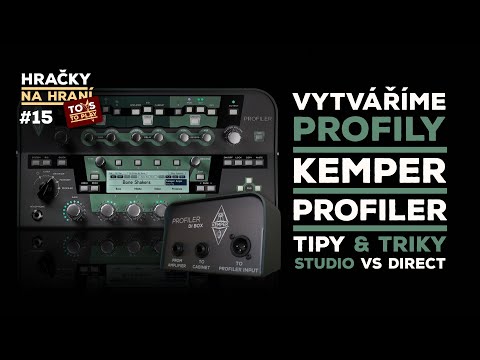Hračky na hraní #15 - Kemper Profiler: Jak na profilování kytarového aparátu

Hello guitarists, welcome to 15th part of Toys. Today's episode is dedicated to those who would like to profile their own guitar rig or even for those of you who are just interested in how it all works. What is profiling? Profiling is a digital technology, thanks to which you can make a fairly accurate digital fingerprint of your guitar rig, your sound for example with Kemper Profiler. There are more and more similar technologies however, Kemper is the market leader and has no competition yet.
And this way you can create a virtual collection of guitar amps and cabs whether from amps you have at home, or you can easily buy profiles as well. WHAT YOU NEED FOR PROFILING What you need for profiling... You surely need Kemper Profiler... Doesn't matter if it's this rack version or toaster or Stage, it's the floor unit. You need a guitar amp with a cabinet and of course you need a microphone or a couple of microphones and microphone cables. There are some stompboxes you can use for profiling so if you have some interesting pedal in your collection that you would like to use for profiling, be sure to prepare it too.
You need a guitar... can't be done without her... :) And of course you need a mixer and monitors it should basically be a studio setup so you can clearly hear the resulting profiles and mixer is necessary when you mix two microphones as well.
And in case you would like to make a DIRECT profile you need a DI box like this, this one is from Kemper especially for making DIRECT profiles. however, every DI box or load box that has a direct output should work. CONNECTIONS Let's connect it! In principle, three connection variants can be used.
Using one microphone, two microphones and even with some more sophisticated post-production, for example from a computer, in combination with one of the previous variants. I think we can start profiling. I start the whole process with micing a guitar cabinet. If you will, like in this case, use two microphones, don't forget to get them perfectly in phase! It will save a lot of headaches. HOW TO CONNECT IT Now I route guitar sub mix from console to patchbay to send the signal into RETURN input on Profiler.
It's basically this wiring, you find this scheme in Profiler manual. In the case of this scenario, you need to be careful that the signal that goes to the Profiler is not doubled, like from another submix or main output. Connect the guitar to main input on the front panel and signal from Profiler's main output connect back to mixer to be alble to listen to profiling results. Signal from DIRECT OUT send by instrument cable to input of your guitar amp. And the microphone sub mix send to Profiler's RETURN INPUT. Before I start profiling, I set a basic EQ, because I know the amp and cab very well and I know what needs to be done.
THE PROFILING At the beginning, it is necessary to find out whether the sound from the profiler is identical to the one coming from your rig. It's good to do this on a console to easily compare soud from the microphones and Profiler. This can be a very long or on the contrary very fast part of the work, depends on the amp you are profiling.
5150 may be difficult to profile in some circumstances the key to success can be a reasonable volume. Here, the correct phasing of the microphone is very important... If it is not in phase, the sound coming from profiler can be drastically different and usually it sounds very bad.
If you want to tune the profile to the smallest possible detail it is necessary to have the guitar box in another soundproofed room so that it does not disturb you when listening. I think I have it... To be honest, the profile will never be totally identical to the original rig but you can get very close! And in the end, you can additionally refine the profile in the Profiler. It has possibilities far beyond a standard guitar amp tone tweaking.
Finally, I can start profiling... Now it's time for so called refining This means you hit your guitar very, very hard and play a few chords. Don't hesitate to play really hard, it's important for finalizing the sound... This refining procedure should last a least 20 seconds to allow Profiler to generate inter modulation in distortion. It doesn't matter which type of guitar or pickups you use, Profiler handles them all.
It's done! Now it's time to save the profile... and give it a meaningful name, such as Profile 367 to make it very clear and easy to find ... Yeah, I could tell long stories about that! :) I will switch to BROWSE mode... to do a final test, if everything works as it should if it interacts well...
I think it's great! We got the first STUDIO profile! STUDIO PROFILE INCL. POST-PRODUCTION When profiling with more sophisticated post-production, for example from a computer, which is the most common today you have to get your DAW or plugin chain, which you have somewhere inside between the microphone or mixer and Profiler. This way of profiling is not that easy it is necessary to pay increased attention to some technical stuff it can change the mic phase for example so it's more for advanced users. MAKING CONNECTIONS However, I can show you how it all works.
I open a Logic project with guitar post-production I want to use for the profile. This is it... First thing you need to do is that on a guitar track this is it is to set input number to send the guitar sub group from mixer in... This will be different for everyone, in my case it is input number six. And we also have to activate recording or input monitoring to get the signal through it.
Again, this will different in each DAW but Logic has a global Input monitoring as well so you have to turn it on to get the signal through. Each DAW has similar feature maybe under a different name and look, but I'm sure you know what I'm talking about. In the meantime I moved to guitar MIX BUS with all the post-production and I turn everything off except equalizers. So if you use compressors dynamic EQs and reverbs, turn everything off.
all these effects you can load to effect slots directly in the Profiler. And finally route the MIX BUS to output in my case it's 13/14 and from output 13 on my patchbay I'm sending signal to Profiler's RETURN. When everything is connected it's good to take a look at latency setting. You can find it in Preferences and latency should be as low as possible. Latency depends on buffer size and it works like this: the smaller the buffer is set the smaller the latency we got.
I think most of you have buffer set to a higher number of samples so you could use more plugins and virtual instruments but for profiling, set it to lowest possible size. As you can see I got roundtrip 1.2 ms, which is really low latency... It is very closely related to the sample rate setting. The higher the sample rate is set, the lower the latency we got. But then it affects the performance of the computer.
So we know all the technical details and we can start profiling. You'll see how this profile sounds in the demos later. DIRECT PROFILES Until now, we have been talking about the production of STUDIO profiles.
But you can also create so called DIRECT profile. It's a profile of your guitar amp only. You can connect a standard guitar cab to Profiler with a DIRECT profile and it will sound and behave as a normal rig with a tube head. To create a DIRECT profile you need the DI box I was talking about earlier. I bought this one, it's Kemper's DI box especially for creating the DIRECT profiles.
DIRECT PROFILES: CONNECTIONS To begin the explanation of direct profiles, I borrowed the diagram from the manual for the Profiler again. Simply put, connect the guitar cab to the head via the DI box. This will ensure the load that the amplifier must have and at the same time you get the direct signal to Profiler's RETURN. Let's take a look at it in real life.
Speaker output needs to be connected to DI box input. and guitar cab is connected to the jack output on DI box. And finally, we send the signal from DI box to RETURN on Profiler. And how does such a direct signal actually sound? Like this! It's not entirely pleasant to the ear. Making a DIRECT profile is a bit like shooting in the dark you won't hear the result until it's done.
The process of making a DIRECT profile is the same as with the STUDIO profile. It begins with a profiling process... continues with refining...
hitting your guitar really hard... and finally by saving and naming the new profile with some easy-to-remember name like for example Direct... 32... Of course, how else... SOUND DEMOS PROFILING WITH PEDALS As I mentioned earlier, you can profile with pedals as well.
Some work better some worse clean boosts work quite well tube screamers or various distortions don't... However you can profile with them as well but you have to tweak the settings a lot and again, it's such a shooting in the dark, until you get a desirable result. THINGS TO DEFINITELY NOT PROFILE WITH Turn off all the modulation pedals like choruses, flangers or phasers. I tried it but it doesn't work at all and it's better to use effects from the effects slot directly in Profiler. BEWARE OF NOISE AND GROUND LOOP Beware of possible noise and unwanted sounds, it means use a hi-quality shielded cables it is good to use a quality console if you mix a signal from two microphones and beware of ground loop! It's a noise from bad earthing.
This can be solved by the red switches on Profiler's back. You can ground or lift ground your input or output and with a suitable combination of settings you can completely clean the ground loop. GET YOUR MICROPHONES IN PHASE If you use two microphones, get them correctly in phase simply put, both microphones should be the same distance from the speaker. This can mess things up a lot! USE MODERATE AMP VOLUME When you creating your basic sound, I recommend that you set a reasonable volume. From my own experience, I know that profiles sound much better if the amplifier is not too loud. WE WILL BE HAPPY TO PROFILE YOUR RIG And finally, rather than a recommendation, such a bit of advertising.
If you do not dare to do so, then we can make an appointment and we can, here at The Barn, profile your guitar rig. So we profiled everything and episode 15 is over! Today it was more educational and next time I'll do some pedal review again. And as usual... If you liked this episode don't forget to subscribe to my YouTube channel right here and be sure not to forget the bell! It notifies you when something new is out... Take a look at all my social profiles... I'm on Instagram, Facebook I got website...
Share, like, comment... Take care and ciao!
2021-06-25 04:02


